Whale sharks are the largest sharks and the largest of any fishes alive today, reaching lengths of up to 60 feet. They are plankton/filter feeders, so they’re not dangerous, says Brad Wetherbee, who takes students in his BIO 492 course, which focuses on field methods for studying sharks and rays, to Mexico to observe whale sharks in the wild.
When Marc began his tenure as president of URI in the summer of 2021, I knew we were in for an adventure. But I couldn’t have imagined that a year later I’d be swimming in the dark blue waters off the coast of Isla Mujeres, Mexico, eye to eye with a whale shark.
By Mary Parlange
August 2, 2021
It’s Marc’s first day at URI, and we are welcomed by a crowd of faculty and staff on our new front lawn. URI’s resident tick expert, Professor Thomas Mather, gives us a can of tick repellent. A group of students presents us with a cantaloupe grown in the teaching garden. Professor Brad Wetherbee invites us out shark fishing. Wait, what?
September 19, 2021
It’s a clear day. Brad Wetherbee and a few of his students are waiting at the Wickford, R.I., docks to usher Marc and me onto the R/V Hope Hudner. We’re joining them on their regular shark-tagging excursion.
Wetherbee, as his students call him, conducts field research on sharks and rays and teaches ecology, marine biology, and shark biology in the College of the Environment and Life Sciences (CELS). He’s popular with students, who love his dry sense of humor. He also runs a summer shark camp for city kids that has been featured on NBC’s Today Show.
Aboard the R/V Hope Hudner out of Wickford. Left to right, Wetherbee lab members with URI president Marc Parlange: Jahnae Drummond ’24, now doing a science and engineering fellowship with Wetherbee; Colby Kresge ’21, now working on his master’s degree; Julian Garrison, M.S. ’23; Parlange; Dario Castillo ’21.
Wetherbee is not a man of many words or expressions. At the helm of the boat, he’s the picture of a crusty fisherman. I can’t get a read on whether he’s happy we’re out here or not, and I’m usually good at reading people. But as we motor out past Point Judith and set out the lines, things start to relax. I get to know the students. Dario Castillo, I learn, is one of only four National Geographic STEM field assistants in the whole country. Colby Kresge will do a master’s degree with Wetherbee. Jahnae Drummond came to URI from Baltimore and is doing research on stingrays.
“Throughout the process, the students and Wetherbee operate with confidence and efficiency, a tight-knit team.”
Then, one of the lines whines, its float bobbing madly, and everyone springs into action. The boat rocks like a roller coaster underfoot. I do my best to reel in the line, but soon my arms give out and Dario, who’s about half my size, takes over. The crew brings aboard a luminous 8-foot blue shark, which they measure, photograph, tag, and release. Throughout the process, the students and Wetherbee operate with confidence and efficiency, a tight-knit team. He glows with pride.
I have a read on him now—Brad Wetherbee is an exceptional teacher with a huge heart.
On the way back to the dock, Wetherbee mentions that Marc and I would be welcome to come along to Mexico next summer for his field research course, BIO 492, which includes swimming with whale sharks.
◣◣◣◣
February 17, 2022
Wetherbee gets in touch with me to share the details of the summer course in Mexico. My August schedule is wide open, so I decide to tag along solo on the two-week adventure, rooming with the other faculty member on the trip, marine affairs assist-ant professor Elizabeth Mendenhall.
Members of Wetherbee’s Wickford crew run water across the gills of a Mako shark while they measure, tag, and photograph the fish, which they then carefully release. Makos are common in R.I. waters, as are blue sharks. Blue sharks are long, sleek, supple swimmers with cobalt backs. Makos are compact and muscular with shorter snouts and longer teeth. They swim incredibly fast in short, jittery spurts.
◣◣◣◣
August 3, 2022
The summer course begins. First, we spend a week on waters close to home—four half-days on the Hope Hudner, learning how to catch, measure, sex, tag, and take tissue samples from sharks. Every day a different student takes the helm of the boat and drives out past Point Judith. I join them one morning, along with CELS Dean John Kirby. Even though the students are brand new at this, they have been taught what to expect, and when the line whines, each one jumps to his or her station to help bring a blue shark aboard. Dean Kirby and I have jobs, too. While two students run water across its gills, the rest of us measure, photograph, tag, and then carefully release the shark. I’m impressed by how much they have already learned about handling sharks and collecting data.
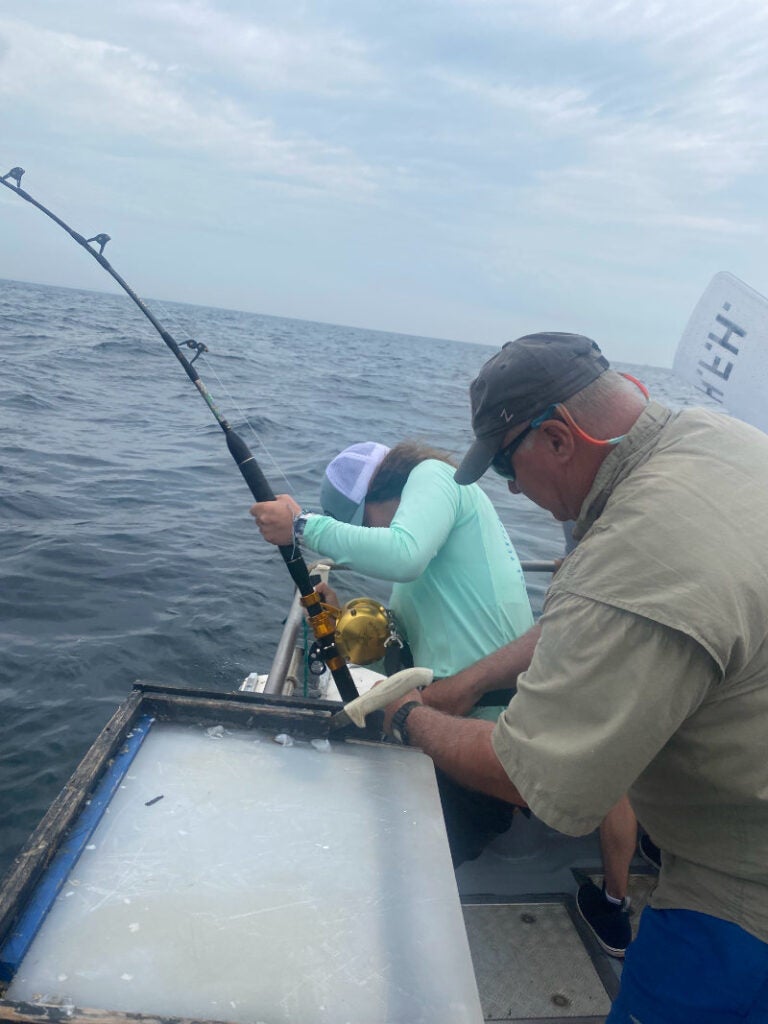
Photo: Rachel Matisko 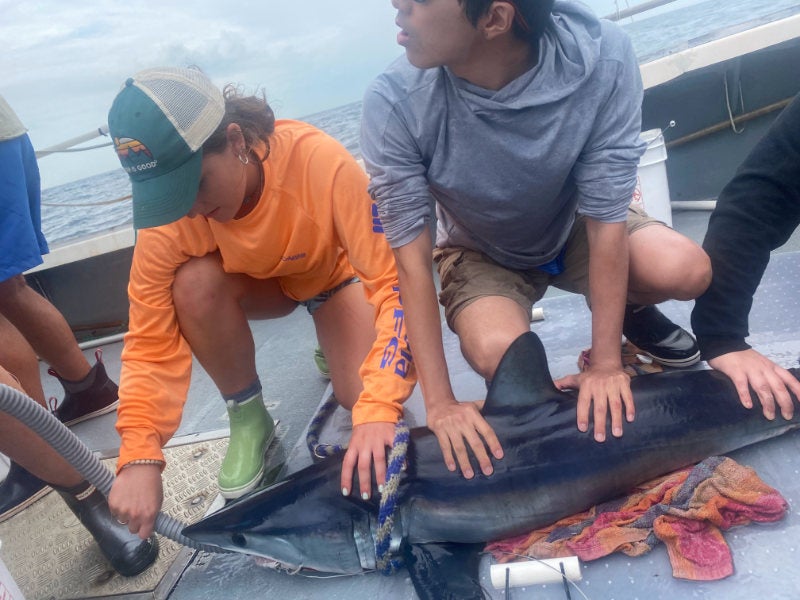
Photo: Rachel Matisko 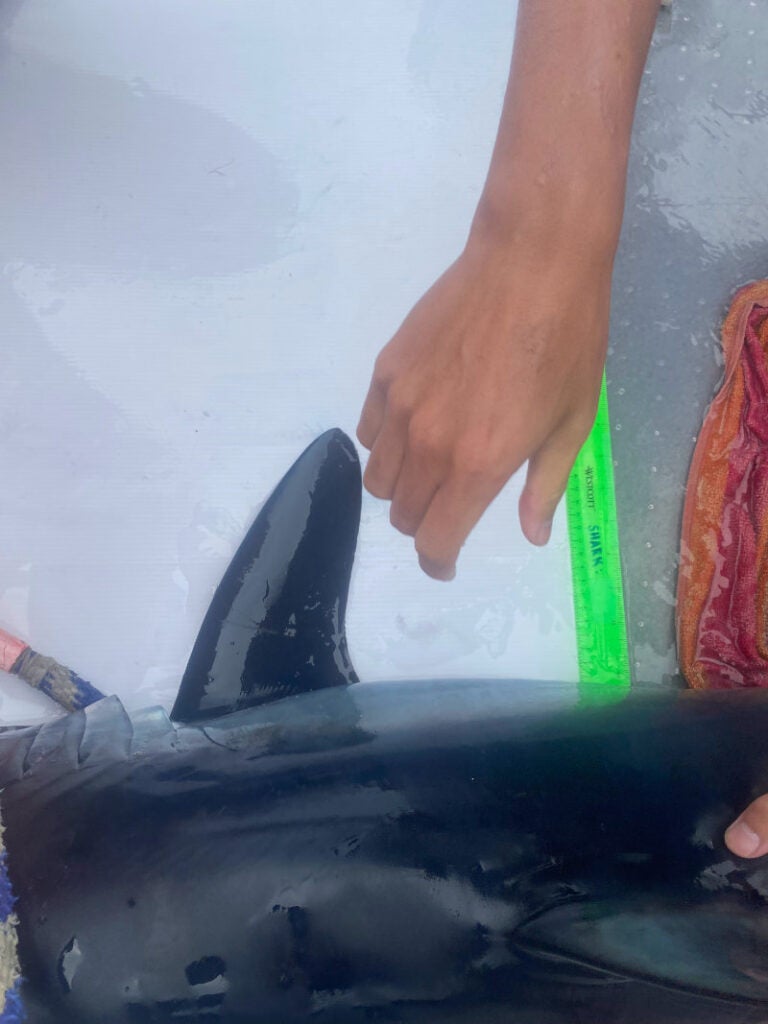
Photo: Rachel Matisko 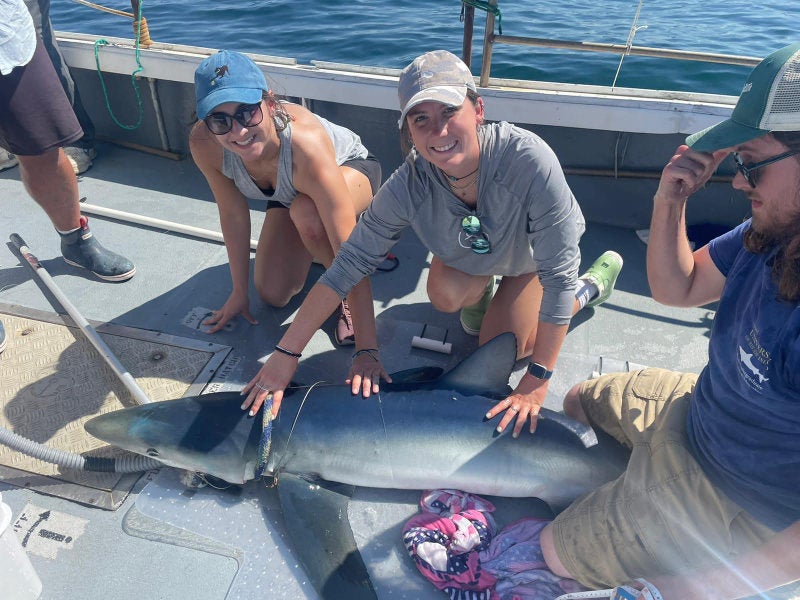
Photo: Brad Wetherbee
August 8, 2022
It’s 7 a.m. and we’re at T.F. Green Airport in Warwick, R.I. A few of the students have never been outside the U.S. before; they’re excited and a little nervous. Professor Mendenhall herself is a little anxious about rooming with the “president’s wife” and I do my best to break the ice. It turns out that she is the perfect complement to Wetherbee on this adventure, building immediate rapport with the students by her relaxed, confident manner. Two graduate student teaching assistants are with us as well: Colby, who was with us on the Hope Hudner, and Dan Daye. We are in good hands.
Soon, we’ve landed, made it through customs in Cancun, and boarded the ferry to Isla Mujeres. Hordes of golf carts putter along streets lined with tourist shops, restaurants, churro trucks, and swing bars (there are literally swings at the counters). Our hotel is right on the beach, run by Rhode Island native Anthony Mendillo Jr. and his wife, Kin. They also own a restaurant and a sportfishing business—Keen M International Blue Water Encounters. His boats, crew, and guides will be taking us out to the sharks this week. The hotel’s golf carts are a hit with the students.
Video: Tony Rendell
August 9, 2022
During the night there’s a huge storm, but morning dawns clear. The seas are still rough, and some of the students regret forgetting to take their Dramamine. Up on the bow of the boat our guide scans the horizon with binoculars. I have no idea how he can spot a shark—every wave looks like a fin to me. Finally, the radio buzzes with something other than, “Nada,” and we join a flotilla of boats surrounding a few fins moving slowly through the water.
“My turn comes. The water is dark, dark blue, the bottom, miles down. The shark is a spotted behemoth gliding powerfully through the water, its mouth a gaping cavern.”
The protocol is this: A guide in the water directs two people at a time to jump in, have a short swim alongside the shark, and then go back to the boat. Of course, the shark is moving, so the boat must keep pace, maintaining a reasonable distance from the swimmer, while not hitting any sharks, people, or other boats. This dance gets increasingly complicated as more boats join the crowd. Wetherbee tells us that in past years hundreds of sharks have aggregated here, and the number of tourist operations getting into the whale shark business has been growing steadily. This year, however, very few sharks are showing up. No one is really sure why—and Wetherbee reminds us that this is another reason that doing research on whale sharks is so important.
My turn comes. The water is dark, dark blue, the bottom, miles down. The shark is a spotted behemoth gliding powerfully through the water, its mouth a gaping cavern. I can see its eyes, the scars on its fins, little fishes hitching a ride alongside. I forget there’s a boat, a protocol—it’s just me and this giant in the silent blue.
And then the shark is past us and the guide waves me back to the boat. The students, full of adrenaline, show each other videos from their GoPros. “That was SO cool!” “I was right next to it!”
Wetherbee beams at their excitement.
For most of the students in the course, swimming with the sharks was the highlight of the trip.
August 10, 2022
The water is much calmer today. Everyone nods off as we motor out. News of a shark sighting crackles on the radio and in minutes, dozens of boats zero in on the spot like ants swarming a speck of food. It’s just one shark, though. The boats line up, depositing and collecting their human payloads. Our students take their turns in the water with the shark and emerge exhilarated.
Our captain, Luis, hears of another spotting. That scene is far less orderly, however, with several boats breaking protocol. Soon the guardaparques, or park rangers, show up with flashing lights and sirens, ordering everyone out of the water. Luis tells us that the downside of the explosion in whale shark tourism is that probably only 30 percent of the drivers are experienced. With hundreds of sharks spread over a larger area it’s manageable, but this is a potentially dangerous situation for people and sharks alike. Luis has had enough. We head off to a nearby reef for snorkelling and ceviche.
August 11, 2022
Today is the one “free” day on the trip, for students to do whatever they want. I decide I need to understand sportfishing, so I charter one of Anthony’s boats for the morning. Wetherbee joins me, along with Colby, Dan, and Emma. I get the first bite—a 25-pound skipjack tuna. Dan reels in a bonito. Then the captain spots it—the ultimate catch, a sailfish! Emma harnesses in and the fight begins. She’s tougher than the fish and shines with joy as she poses for the obligatory photo, before the fish is released back into the blue.
Flashes of neon yellow and blue indicate a school of mahi-mahi. Unlike the sail, this is a fish we can keep. We’re about to give up for the day when the captain spots another sail. This time Colby has the rod, and the fish puts up an epic fight. We all line up for another photo, Colby grinning ear to ear.
On the way back to port, Wetherbee, who didn’t catch a single fish, is smiling like the Cheshire cat. “It’s moments like this…” he says, trailing off. “I’m so happy he caught that fish.”
Dan Daye, M.S. ’23, shows off his catch, a skipjack tuna. One of Wetherbee’s teaching assistants, Daye studied the movements and migrations of whale sharks, including one named Rio Lady, which he tracked for four years, the longest recorded track ever.
Showing off their catch—a sailfish! From left, a boat mate from Blue Water Encounters, Emma Hughes ’26, Wetherbee, Mary Parlange, and Colby Kresge ’21.
August 12, 2022
The full moon is setting behind a cloud as we motor out on calm seas. Somewhere there’s a fin cutting that smooth surface, a whale shark vacuuming up its breakfast.
Luis spots a pod of dolphins in the distance and changes course to intersect with them, cutting the engine so we can jump in the water. Below the surface, it’s a cacophony of clicks and squeaks, the dolphins plunging under and around us. I take off, kicking my flippered feet as fast as I can. A big one swims circles around me. I can reach out and touch them! They’re talking to me! I’m in the pod! One of them lets loose a stream of poop right in front of me. I surface and reorient myself, listening as the clicks fade. The high of this incredible interspecies experience stays with us for the remainder of the trip. I would have come to Mexico just for this.
When we arrive at the site of a shark sighting, we count 120 boats, including the guardaparques. Instead of joining the chaos, we take turns jumping off the bow of the boat and then head to the reef, where we see a sleeping sea turtle, a small shark in a crevice, and a pod of cuttlefish.
“I reflect on something Wetherbee told me before the trip—that there is nothing quite like observing whale sharks in the wild. And now I understand.”
I chat with some of the students about what they want to do with their lives. “I want to be Dr. Wetherbee when I grow up,” says Rachel. Hailey wants to study the reproductive lives of fish. “Did you know some fish species have three sexes?” She knows the names of many fish, having worked in a pet store, but this is the first time she’s been to a reef. Julianne wants to teach high school science. Steph contemplates turning her wildlife biology major into a job as a fish and game warden and is happy she’s been able to spend so much time on the boat without getting seasick.
Every evening we have listened to presentations—Wetherbee; teaching assistants Colby and Dan; Professor Mendenhall; and a colleague of Wetherbee’s, Mahmood Shivji, director of the Guy Harvey Research Institute at Nova Southeastern University in Florida. For the next two evenings, the students are the teachers. Working in pairs, they share what they have learned about whale shark ecology, from ecotourism to field methods to population dynamics and migration patterns.
Later, I head out into the warm night to visit the sea turtle hatching zone on the beach outside the hotel. Volunteers collect eggs laid on the island’s beaches, tend them, and then release them when they are ready to go—protecting them from predators at every stage of the journey. Earlier in the week, we saw three big turtles digging their nests into the sand near the pool. Tonight, under the red of their headlamps, the volunteers show us a bin of hatchlings. One day they, too, will crawl up on this same beach to lay their eggs.
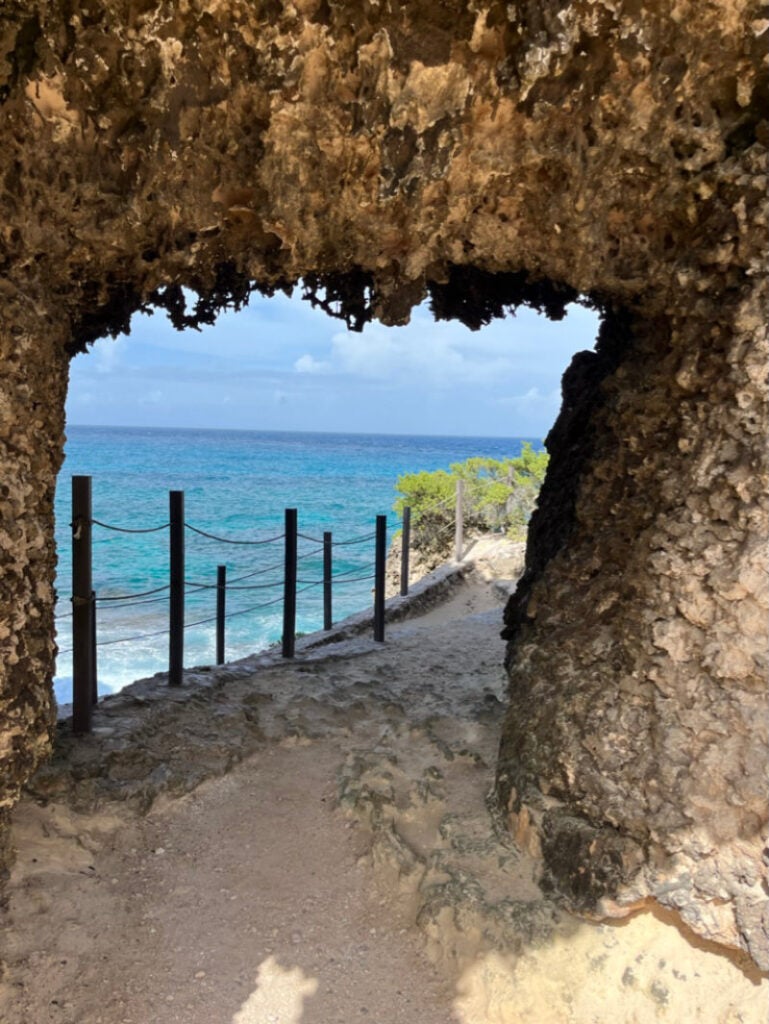
Photo: Colby Kresge 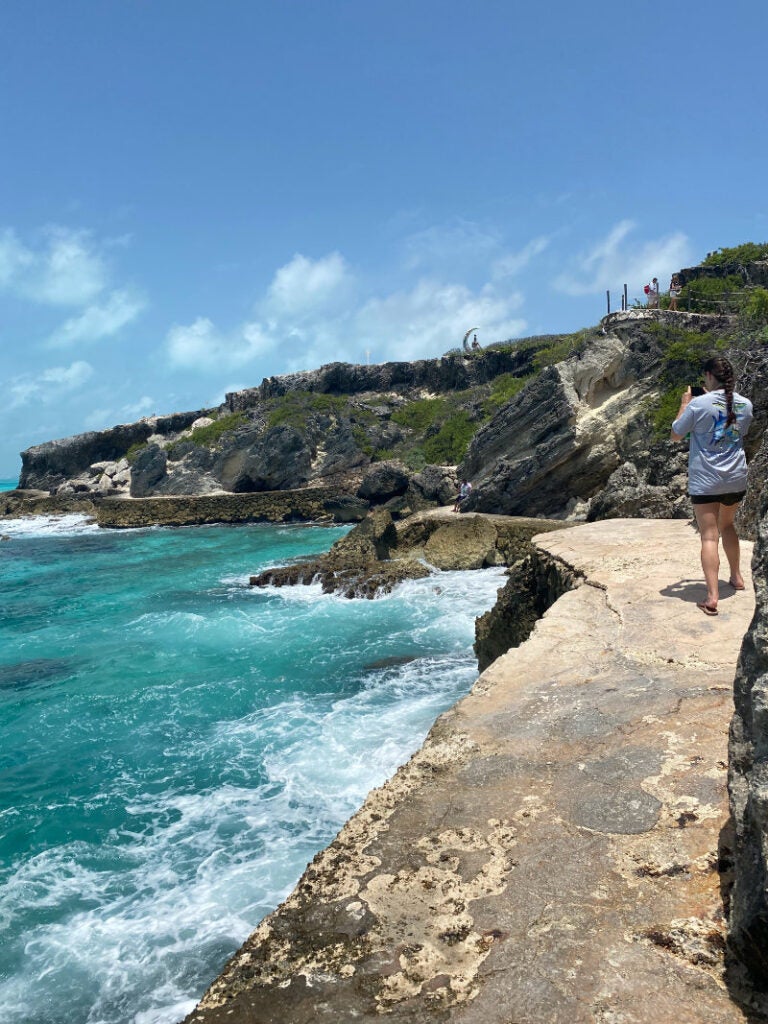
Photo: Lily Fitzgerald 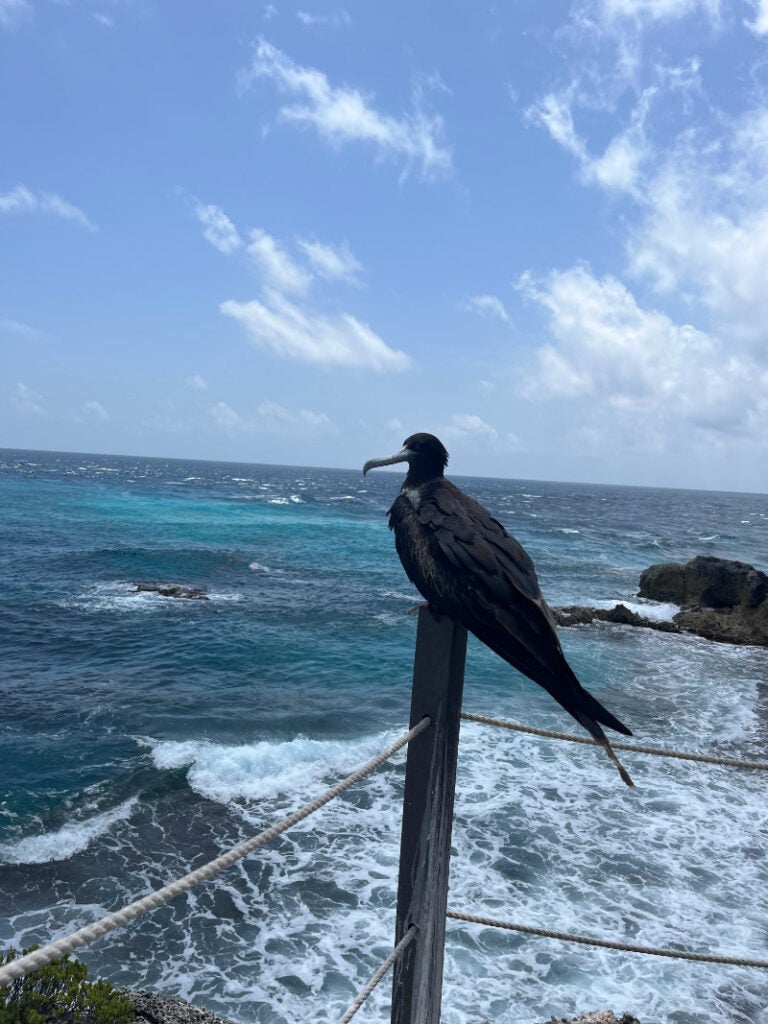
Photo: Lily Fitzgerald 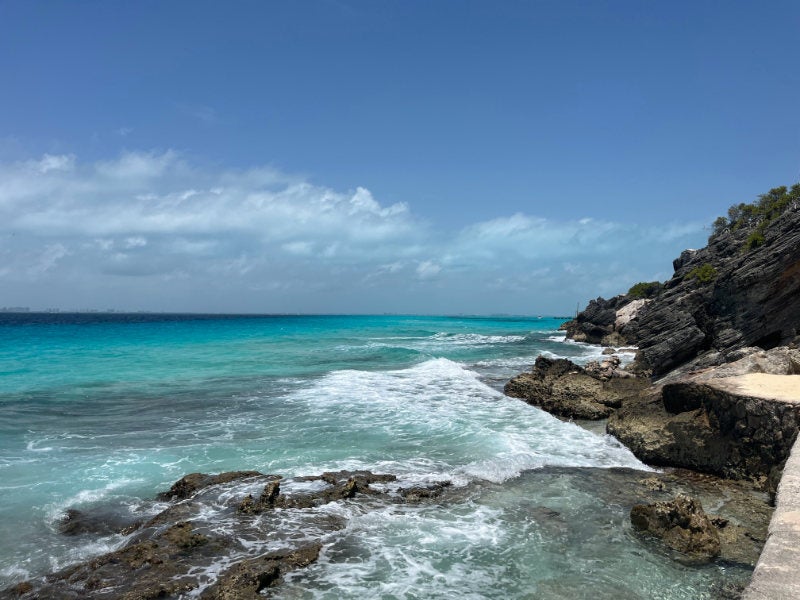
Photo: Sam Abernovich 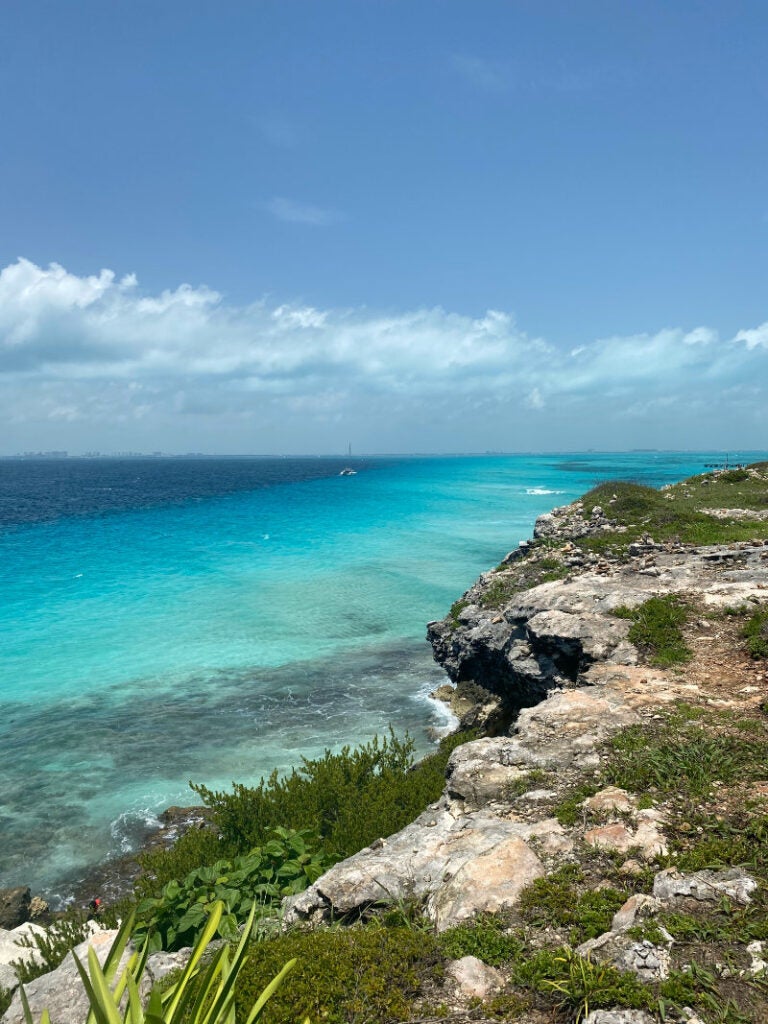
Photo: Lily Fitzgerald 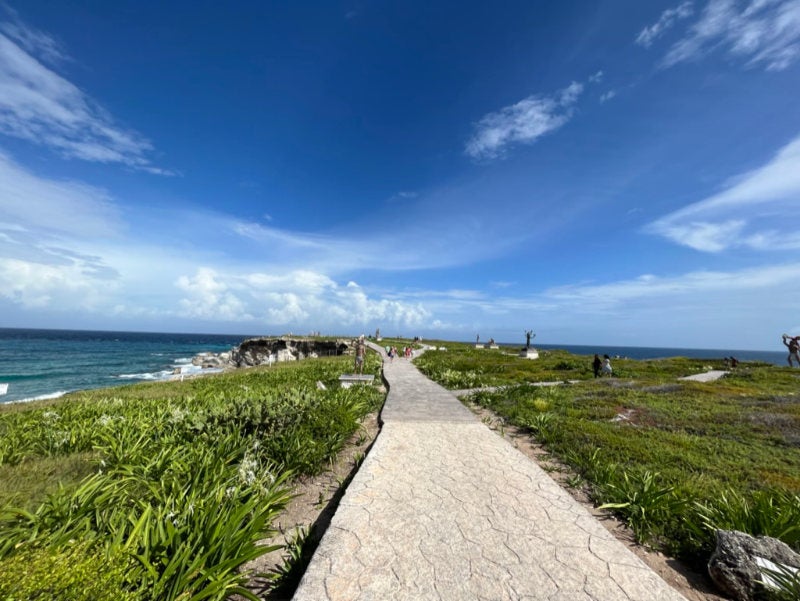
Photo: Colby Kresge 
Photo: Colby Kresge 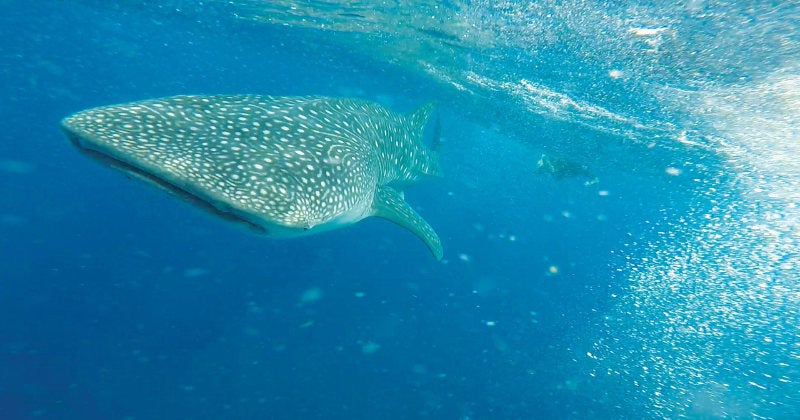
Photo: Julianne Favale 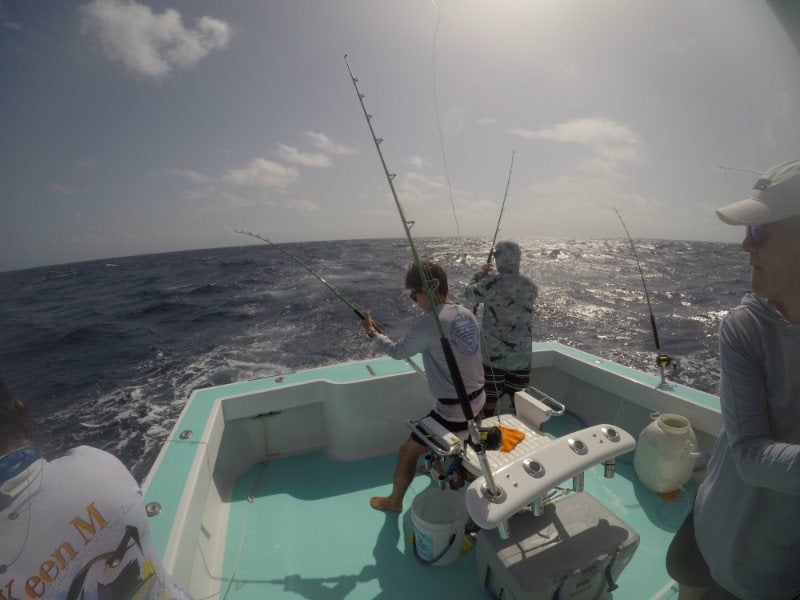
Photo: Brad Wetherbee 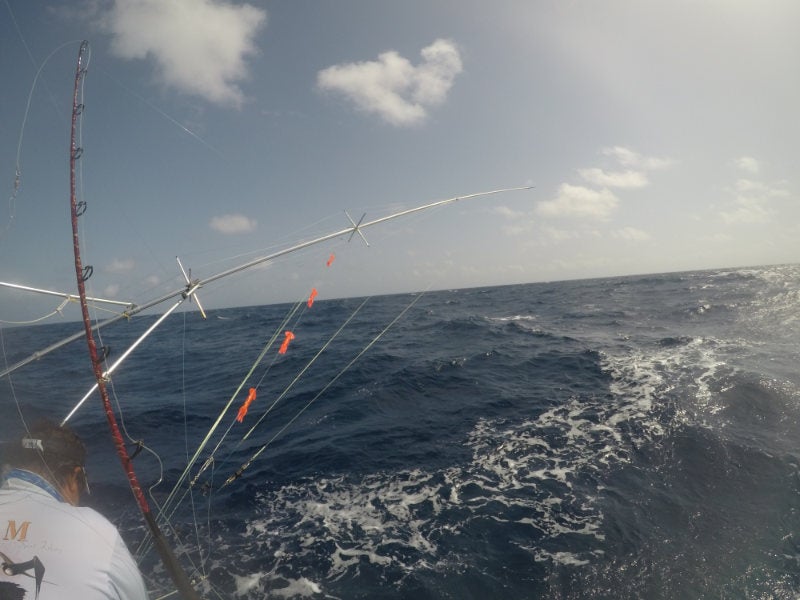
Photo: Brad Wetherbee 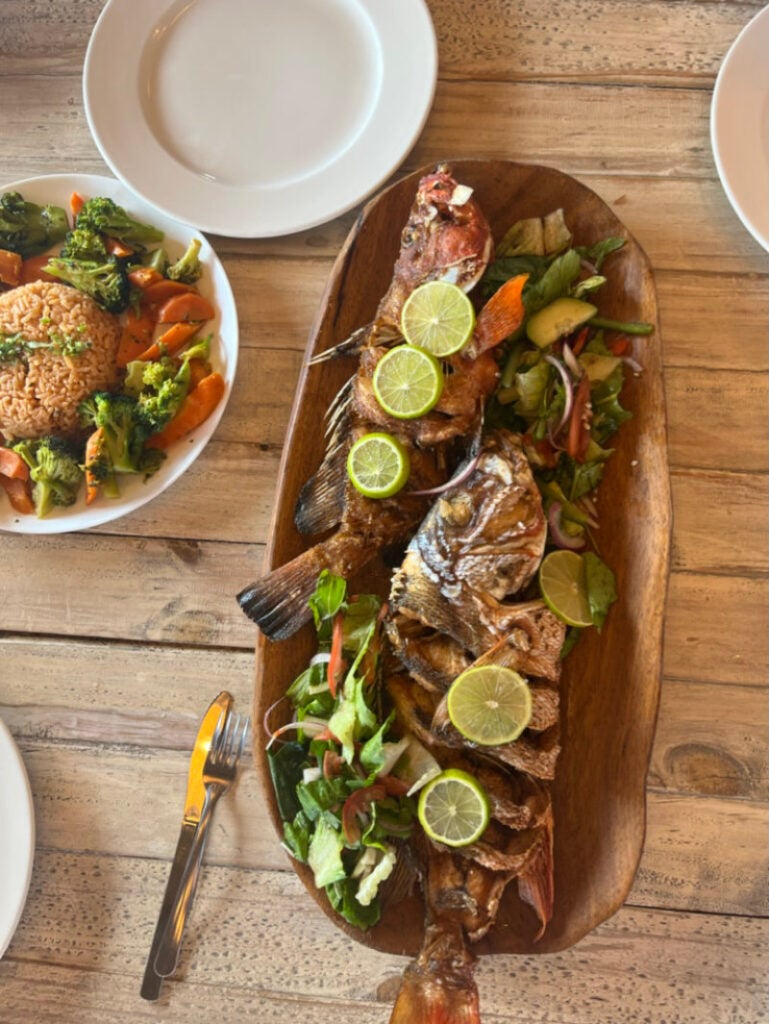
Photo: Colby Kresge 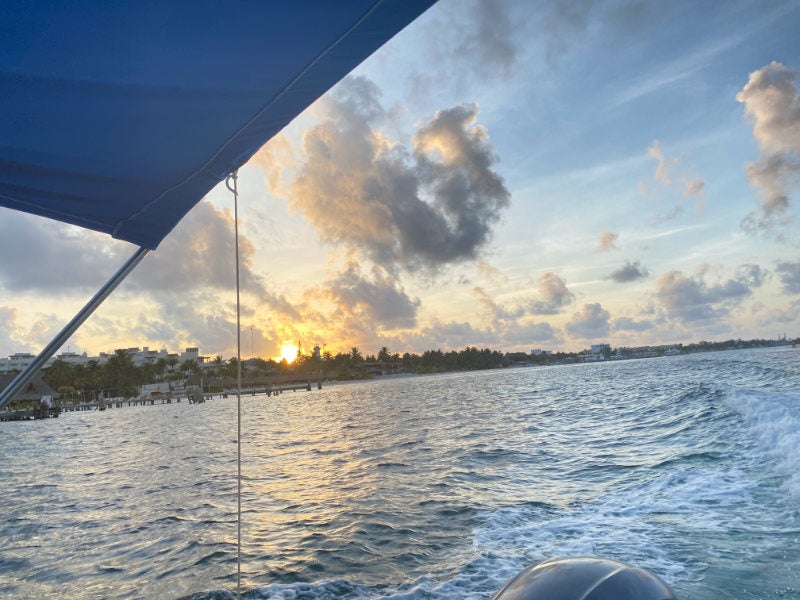
Photo: Lily Fitzgerald 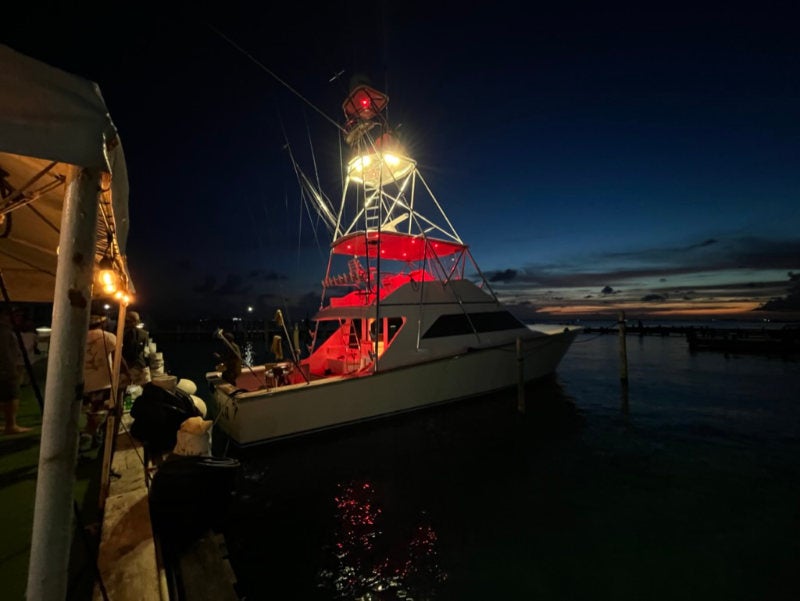
Photo: Colby Kresge 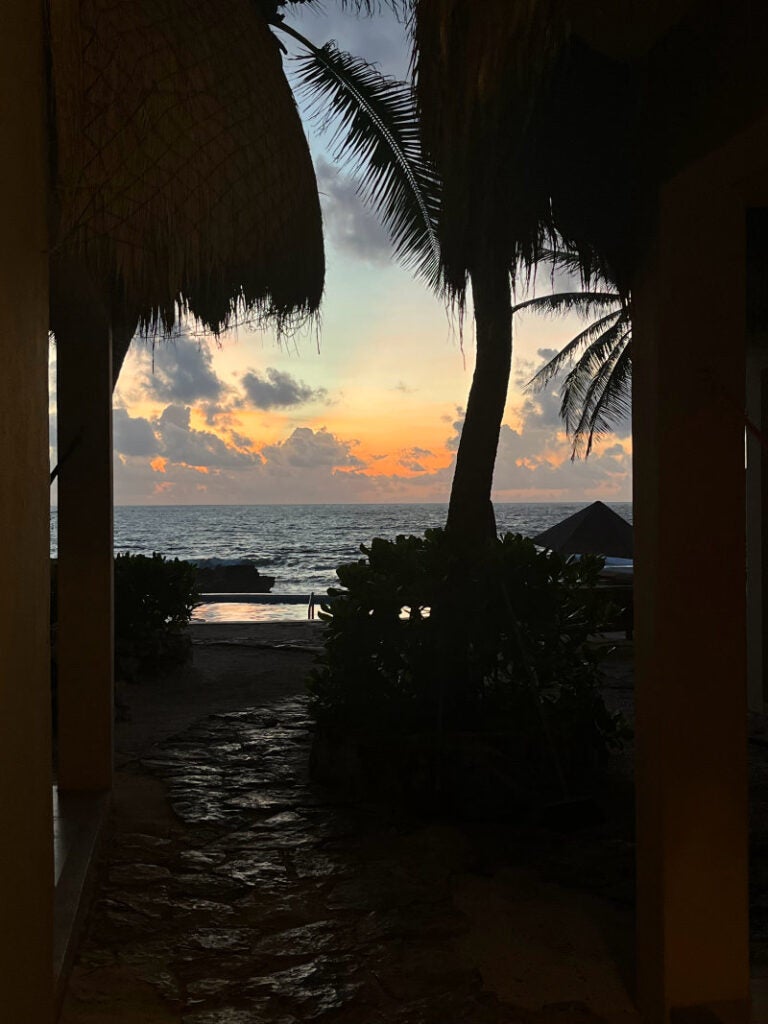
Photo: Sam Abernovich
August 13, 2022
On the last evening of the trip, we feast at Anthony’s restaurant—on the fish we caught. I reflect on something Wetherbee told me before the trip—that there is nothing quite like observing whale sharks in the wild. And now I understand. Demographics, feeding, measurements, the impact of tourism—all these topics related to whale sharks, topics that the students in the course have studied—mean something different when you see and experience the sharks in this environment. And you really realize how little we know and how hard it is to get reliable data.
August 14, 2022
In the Cancun airport, I talk with some of the students. For most, swimming with the sharks was the highlight of the trip. They appreciate that they were able to witness firsthand the impacts of ecotourism on the local culture and on the sharks. They learned to drive a boat, tag a shark, and explore an aspect of whale shark ecology in depth and present it to others. And every student mentioned the value of the friendships and memories they made together.
“It was cool to be with a group of students who have the same academic interests and the same passion for sharks as I do,” says Emma. “Other people would say, ‘Get out of the water! There’s a shark!’ But we were like, ‘Yay! A shark! Let’s go look at it!’”
Wetherbee tells me, “It’s great to see these students experience another country and culture while learning about a species as impressive as whale sharks.”
Mary Parlange (left) and marine affairs assistant professor Elizabeth Mendenhall in a free moment on Isla Mujeres. Mendenhall, whose research focuses on global ocean governance, says, “I enjoyed watching the students become more confident and capable—in the water, in another country, and working together as a group. The whale sharks were magical, but it was emotional, seeing the sharks surrounded by tourist boats. I wanted to be there but simultaneously wanted to leave those sharks alone.”
◣◣◣◣
April 28, 2023
We have a reunion, reliving the adventure with a slideshow at my house. Several of the students have become fast friends, taking Wetherbee’s shark biology class together, and this summer a couple of them will join his next shark adventure—to South Africa to see great whites in the wild. I’m a little envious that I’m not going to be with them. Who knows? Maybe in 2024.
Photos: Chelsea Berry, Colby Kresge, iStock, Rachel Matsiko, Mary Parlange, Julianne Favale, Brad Wetherbee
Meet Mary
Since arriving at URI in 2021, Mary Parlange has pursued her interest in environmental issues and sustainability by organizing discussions that bring students, faculty, and local business leaders together. She has become a certified Master Gardener and is involved in URI’s Free Farmer’s Market. She is passionate about community-building at URI, with a particular interest in welcoming and assisting international students, scholars, and their families. Parlange has a B.A. in philosophy from Pomona College and an M.S. in atmospheric science from the University of California, Davis. She has been a writer, editor, translator, and media relations professional for more than 25 years.

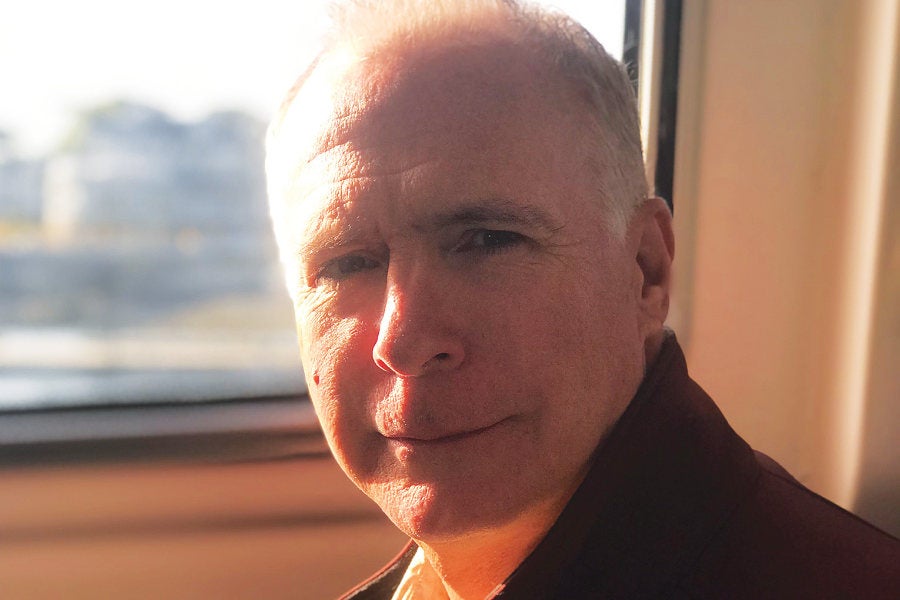
Great job Mary! Loved reading the article.
I LOVED this article. When the Parlanges came to URI I remember reading Marc’s story and thinking how much our paths seemed alike and that he was going to make a great university president. They’ve lived all over the world as I have and their interest in education seemed very familiar. What I didn’t know was much about Mary. This article allowed me to see her side of adventure and I related to this story immensely. I once traveled as a chaperone to Costa Rica when my friend who taught the International Development course needed a female to accompany him as a chaperone. What a blast I had with those students, that was in 1999. I had no idea that my future would evolve the way it was about to do… I am just now returning to Rhode Island after teaching science and math overseas since 2007.
Well done on this article on the Mexican trip. I liked the format of being like a journal as I’ve made many of my own as I’ve moved around the world . I am writing this from my house in Trinidad 🇹🇹 as we speak and flying in a week back to my current home in El Salvador 🇸🇻 where I just finished a two year teaching contract to close out the house I rent there. Thank you so much for this month’s magazine ~ BRAVO!
I have always loved URI for many reasons but this months magazine is really highlighting many of my favorite topics. Keep up the good work and I am hoping to connect with Mary Parlange after I return in August. She is a breath of fresh air for our state and I have a bunch of people I think she’d enjoy meeting.
Such a great experience! So impressed the students were able to really be hands on. Also, knowing one of the participants, of whom I’m so proud is Dan…and his Nova Scotia roots.